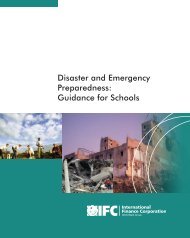Education as "a social vaccine" in the fight against HIV/AIDS - INEE
Education as "a social vaccine" in the fight against HIV/AIDS - INEE
Education as "a social vaccine" in the fight against HIV/AIDS - INEE
- No tags were found...
Create successful ePaper yourself
Turn your PDF publications into a flip-book with our unique Google optimized e-Paper software.
<strong>in</strong>terested <strong>in</strong> enterta<strong>in</strong><strong>in</strong>g drama and videos than <strong>the</strong> messages <strong>in</strong> <strong>the</strong>se shows 10 which may meanthat <strong>the</strong>ir attention is less when it comes to more educative movies. These shows are alsopresented outside and open to everybody and it is not clear whe<strong>the</strong>r <strong>the</strong>ir messages are agespecific,yet <strong>the</strong>re is <strong>in</strong>evitable attendance of young children. Thus, although <strong>the</strong> messages areunderstood, questions from young people are likely to rema<strong>in</strong> unanswered because of <strong>the</strong>presence of <strong>the</strong>ir parents.To fur<strong>the</strong>r understand whe<strong>the</strong>r <strong>the</strong> messages <strong>in</strong> <strong>HIV</strong>/<strong>AIDS</strong> education are understood, it will beimportant to consider <strong>the</strong> language used. It should be realised that <strong>in</strong> Uganda, like <strong>in</strong> o<strong>the</strong>rAfrican countries, oral cultures are still largely common where children learn from what <strong>the</strong>irparents tell <strong>the</strong>m through <strong>in</strong>formal education. As Birgit (2000:49) po<strong>in</strong>ts out, <strong>the</strong> normal way tolearn is through <strong>the</strong> examples and oral <strong>in</strong>formation given by <strong>the</strong> family, elders and <strong>the</strong> teacherbecause <strong>the</strong>se are listened to. They use <strong>the</strong> language that is well understood to everybody. Theimportance of <strong>the</strong> use of mo<strong>the</strong>r tongue is recognised by UNESCO contend<strong>in</strong>g that teach<strong>in</strong>g <strong>in</strong> amo<strong>the</strong>r tongue is a way to foster <strong>in</strong>clusion (EFA Report 2007). Ignor<strong>in</strong>g this fact puts teach<strong>in</strong>g<strong>HIV</strong>/IDS <strong>in</strong> schools at stake.In <strong>the</strong> first <strong>in</strong>stance, parents are rarely <strong>in</strong>volved <strong>in</strong> teach<strong>in</strong>g children about <strong>the</strong>ir gender roles anddevelopment to adulthood, yet <strong>the</strong>y are <strong>the</strong> ones who use <strong>the</strong> language that <strong>the</strong>ir childrenunderstand. The re<strong>as</strong>on given to ignore <strong>the</strong> role of parents is that due to cultural re<strong>as</strong>ons, parentsdo not talk to <strong>the</strong>ir children directly about sex matters. At this po<strong>in</strong>t, I argue that <strong>as</strong> long <strong>as</strong> <strong>the</strong>yare not <strong>in</strong>volved <strong>in</strong> education efforts, most messages will not be understood. I f<strong>in</strong>d <strong>the</strong> idea ofgiv<strong>in</strong>g <strong>in</strong>formation to parents about <strong>HIV</strong> transmission and how it can be prevented, effects ofstigma and discrim<strong>in</strong>ation among PLHAs and how appropriately <strong>the</strong>se messages can be conveyedto <strong>the</strong>ir children more appeal<strong>in</strong>g. This is because, <strong>in</strong> predom<strong>in</strong>antly day schools where childrenspend most of <strong>the</strong> time with <strong>the</strong>ir parents, a lot can be done while at home. Most materials used toteach <strong>HIV</strong>/<strong>AIDS</strong> education such <strong>as</strong> leaflets and posters are written <strong>in</strong> a foreign language, English.It is true that <strong>as</strong> <strong>the</strong>y are distributed, many people receive <strong>the</strong>m both <strong>in</strong> and out of school to <strong>as</strong>high <strong>as</strong> 80% (Mitchell, et al., 2001). Low literacy rates (UBOS Statistical Abstract 2006) 11 <strong>in</strong>rural are<strong>as</strong> however, may help to expla<strong>in</strong> whe<strong>the</strong>r <strong>the</strong> messages <strong>the</strong>re<strong>in</strong> are understood or notwhich ma<strong>in</strong>ly depends on <strong>the</strong>ir ability to read <strong>the</strong>m. Lack of read<strong>in</strong>g culture also affects <strong>the</strong>understand<strong>in</strong>g of messages <strong>in</strong> <strong>the</strong> leaflets. From this analysis, I argue that although IEC<strong>in</strong>tervention is preferred <strong>in</strong> <strong>HIV</strong>/<strong>AIDS</strong> education because of <strong>the</strong> mere fact that it reaches <strong>the</strong> wide10 I led a team of university students to sensitise <strong>in</strong>-school adolescents about reproductive health issues <strong>in</strong> February,2001 supported by PEARL Project <strong>in</strong> <strong>the</strong> M<strong>in</strong>istry of Gender, Labour and Social Development. We used film showsbut some students always <strong>as</strong>ked for more enterta<strong>in</strong><strong>in</strong>g videos with music or ‘action movies’.11 Accord<strong>in</strong>g to Statistics report, literacy rate <strong>in</strong> rural are<strong>as</strong> is 67% compared to 87% <strong>in</strong> urban are<strong>as</strong>.14
















